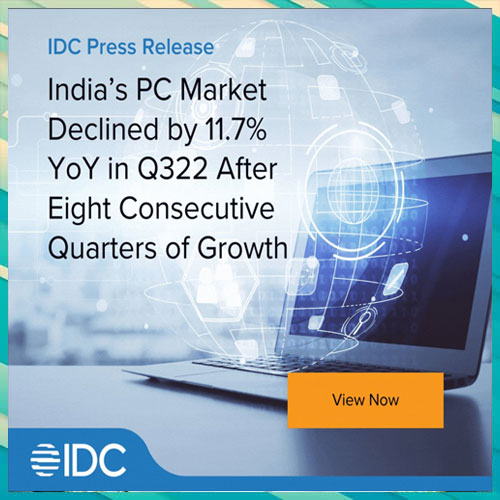
The India traditional PC market, inclusive of desktops, notebooks, and workstations declined by 11.7% year-over-year (YoY) in Q32022 (Jul-Sep) after eight consecutive quarters of growth despite strong shipments of 3.9 million units, according to new data from the International Data Corporation (IDC) Worldwide Quarterly Personal Computing Device Tracker. All segments declined except the government, which grew by 91.5% YoY as government orders materialized, leading to strong growth for the third consecutive quarter. While the desktop and workstation categories grew by 23.4% and 17.6% YoY respectively, the notebook category declined by 19.5% YoY. The demand for notebooks has softened across segments, forcing vendors to clear inventory.
The consumer segment shipped 2.1 million units with online sales helping in picking up momentum at the end of September. However, that was not sufficient to prevent a 10.9% YoY decline. Similarly, the commercial segment was impacted due to a delay in enterprise orders as well as muted SME sentiment, leading to a YoY decline of 12.5%.
While the demand for premium notebooks (>US$1,000) declined sharply by 28.5% YoY in the commercial segment, premium consumer notebooks grew by 9.8% YoY. The strong performance by Apple and good traction for ASUS’ gaming notebooks were the key drivers.
“With schools and colleges opening, the consumer segment is seeing tapering demand for the past few months as demand for remote learning has come to a standstill. Weakened currency is resulting in rising device costs and pricing pressure for vendors. As the online sales were going on, vendors delayed price increases in Q3, but the discounts weren’t as lucrative as in previous years either. Vendors are expected to increase prices in Q4, which might further dampen sentiment,” said Bharath Shenoy, Senior Market Analyst, IDC India.
Top 5 Company Highlights: 3Q22
HP Inc. shipped over 940,000 units and continued to lead the overall PC market with a share of 23.9% in 3Q22. Its consumer share dipped to 22.1% and commercial share dipped to 25.9% as it focused on inventory corrections, but it continued to lead both segments.
Lenovo overtook Dell for the second position with a strong showing in the consumer segment where it continued to hold its second position with a share of 18.8% thanks to online sales. In a quarter of softening SME procurement, Lenovo led the segment with a share of 32%.
Dell Technologies slipped to the third position as it lost momentum in the consumer segment as it decided to stay away from online sales. But it stood at a close second behind HP in the commercial segment with a share of 25.3%, where it continued to have good traction.
Acer Group continued to hold the fourth position with a share of 10.9%. Acer witnessed strong traction in the commercial segment as it grew by 28.2% YoY there. It led the commercial desktop category with a share of 31.3%, driven by fulfillment of several enterprise and government orders plus good traction in GeM space (Government eMarketplace) for its commercial desktops.
ASUS maintained fifth position with a share of 9.9%, much higher than the 8.5% share it had in 3Q21. The vendor was third in the consumer segment with a share of 18.2%, marginally behind Lenovo. In the consumer notebook category, it managed to hold second position behind HP and ahead of Lenovo with a share of 20.6%. The vendor performed well during online sales and has also been expanding its offline reach, which helped it to gain share.
See What’s Next in Tech With the Fast Forward Newsletter
Tweets From @varindiamag
Nothing to see here - yet
When they Tweet, their Tweets will show up here.





























